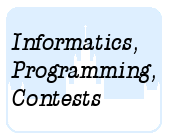Подразделы
Другие разделы
Дата и время
05/01/2026 06:49:37
 761. Hypertheseus
761. Hypertheseus
 Задача
Задача
 Олимпиадные задачи на английском языке
Олимпиадные задачи на английском языке
| 04/02/2008 | Тренировка (задачи CTU Open Contest 2007) (t) |
| 04/02/2008 | Зима 2008 дорешивание (1t) |
Ограничения: время – 2s/4s, память – 64MiB Ввод: input.txt или стандартный ввод Вывод: output.txt или стандартный вывод 
Послать решение Blockly Посылки Темы Где Обсудить (0)
For one of their clients, ACM prepares a TV advertisement that features ancient heroes, for
example Prometheus, Achilles, Odysseus and many others. To demonstrate how difficult was
life for these heroes, ACM runs computer simulations of their most famous tasks. In this problem,
we will try to solve the problem of Theseus.
Theseus was an Athenian hero who killed Minotaur, the half-man, half-bull monster residing in
an inescapable Labyrinth constructed by Daedalus. The hardest part of Theseus’ task was not
killing the monster — the legend says Minotaur was just sleeping when Theseus came to him.
Thus, the hero was able to batter the monster with his bare hands. But then the real challenge
came: to find the way out. As you may know, Ariadne, beautiful daughter of king Minos, played
an important role in this part. But that’s a different story.
As the technology advanced a lot since the ancient times, there are several important differences
in today’s simulations:
1. Labyrinth-making skills advanced as well. Two-dimensional labyrinths are not a big challenge
anymore. Thus, our labyrinth is d-dimensional. It looks like a regular ”grid” of `n_1\ times\ n_2\ times\ …\ times\ n_d`
(hyper)cubes, each of them being either empty (corridor) or filled with a rock (wall). Theseus
moves in steps, each step means travelling between two neighboring empty hypercubes in any
dimension. Two hypercubes are considered neighboring, if and only if the difference in their
space coordinates is exactly one in one dimension, and zero in all other dimensions.
2. Our Minotaur is stronger, thus, it is no more possible to batter him with bare hands. Theseus
must use a sword which lies somewhere inside the labyrinth. Note that before he takes the sword,
he cannot go through the hypercube where Minotaur resides!
Input Specification
The input consists of several labyrinth descriptions. Each description begins with a line contain-
ing a single integer number `d` `(2\ ≤\ d\ ≤\ 20)` — the number of dimensions. On the second line of
each description, there are d integer numbers n1, n2, …, nd separated by spaces. These numbers
give the size of the labyrinth in every dimension, measured in unit hypercubes `(∀i\ :\ 2\ ≤\ n_i)`. You
may assume that the total number of hypercubes in any labyrinth will not exceed `2^20\ =\ 1048576`.
Then a labyrinth map follows, the description is defined recursively: Two-dimensional labyrinth
(of the size `n_1\ times\ n_2`) is described by `n_2` lines containing n1 characters each. Every character
describes a single hypercube ("square" in the case of 2 dimensions) and is either '#' (rock),'.'
(free space), or one of uppercase letters 'T' (Theseus’ position), 'M' (Minotaur), and 'S' (sword).
Each of these three objects will appear exactly once in the whole labyrinth. The hypercubes
containing the letters are considered ”empty” otherwise, i.e., Theseus can walk (and must walk)
through them.
For better clarity of the input, each two-dimensional map is followed by one empty line.
For `d\ >\ 2`, any `d`-dimensional labyrinth is a sequence of `n_d` "layers", each layer being a description
of a `(d\ -\ 1)`-dimensional labyrinth.
The last labyrinth description is followed by a line containing zero. This line terminates the
input and no output should be produced for it.
Output Specification
For each labyrinth, output the sentence ''Theseus needs `S` steps.'', where `S` is the smallest
possible amount of steps needed to reach the hypercube with the sword, the hypercube with
Minotaur, and then back to the original Theseus’ position (where the exit is supposed to be). It
is not possible to leave the labyrinth area, i.e., all hypercubes outside the labyrinth are considered
rocks. Exit may appear in an inner hypercube, it may not reside on the "border".
If it is not possible to solve the situation at all, output sentences "No solution. Poor Theseus!"
Sample Input
2 3 3 T.. M#. S.. 2 3 2 T#S ..M 3 4 4 3 #S.. ###. #M.. ###. .### .### .### .... .... ###. ###T #### 0
Sample Output
Theseus needs 8 steps. No solution. Poor Theseus! Theseus needs 40 steps.

 Начало
Начало